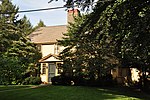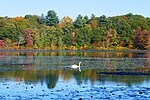House at 152 Suffolk Road
Colonial Revival architecture in MassachusettsHistoric district contributing properties in MassachusettsHouses completed in 1900Houses on the National Register of Historic Places in Newton, MassachusettsNRHP infobox with nocat ... and 2 more
National Register of Historic Places in Newton, MassachusettsNewton, Massachusetts Registered Historic Place stubs

The House at 152 Suffolk Road in the Chestnut Hill area of Newton, Massachusetts is a rare local example of the Spanish Mediterranean style of Colonial Revival architecture. The house, built in 1904, is set apart from more typical Colonial Revival structures by its use of ceramic tile as roofing, stucco walls, and a Mediterranean-style loggia.The house was listed on the National Register of Historic Places in 1986, and included in an expansion of the Old Chestnut Hill Historic District in 1990.
Excerpt from the Wikipedia article House at 152 Suffolk Road (License: CC BY-SA 3.0, Authors, Images).House at 152 Suffolk Road
Suffolk Road, Newton Chestnut Hill
Geographical coordinates (GPS) Address Nearby Places Show on map
Geographical coordinates (GPS)
| Latitude | Longitude |
|---|---|
| N 42.328611111111 ° | E -71.1725 ° |
Address
Suffolk Road 170
02159 Newton, Chestnut Hill
Massachusetts, United States
Open on Google Maps








